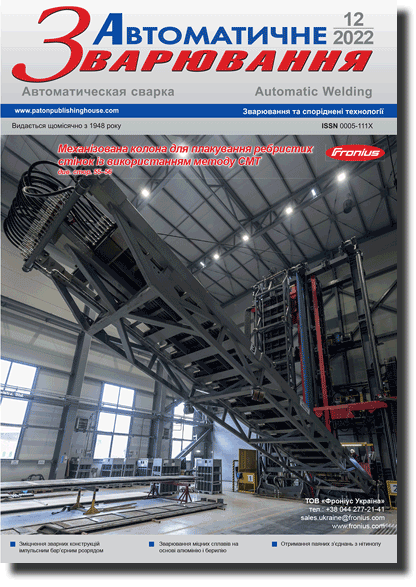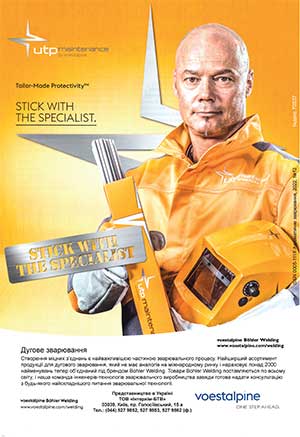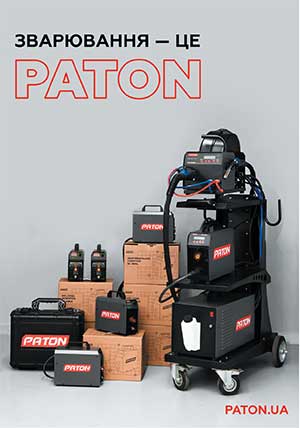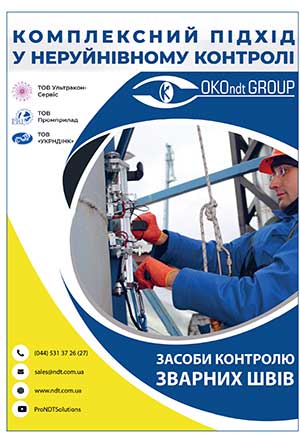| 2022 №12 (07) |
DOI of Article 10.37434/as2022.12.01 |
2022 №12 (02) |
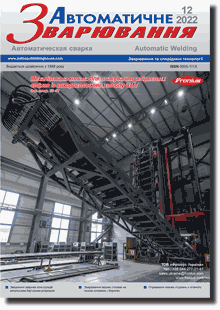
"Avtomatychne Zvaryuvannya" (Automatic Welding), #12, 2022, pp. 3-8
Strengthening of welded structures of 25KHGNMT steel by pulsed barrier discharge treatment
L.M. Lobanov1, O.M. Berdnikova1, M.O. Pashchyn1, O.L. Mykhoduj1, O.S. Kushnaryova1, T.G. Solomiychuk1, V.I. Kryvyi2
1E.O. Paton Electric Welding Institute of the NAS of Ukraine. 11 Kazymyr Malevych Str., 03150, Kyiv, Ukraine. E-mail: office@paton.kiev.ua2Scientific and Production Association Praktika, 15, Metalistiv Str., 03057, Kyiv, Ukraine
The development of high-tech industries stimulates the growth of requirements for metal of welded structures, a complex of their basic and special properties. The use of pulsed electric currents, plasma currents, pulsed electromagnetic fields and their combined effects to improve the mechanical characteristics of metals and alloys is relevant in connection with the need in replacing traditional energy-intensive technologies of treatment of welded structures with more progressive. The use of a pulsed barrier discharge (PBD) in the metal treatment, which generates low-temperature plasma on the surface of the treated metal is a new approach to optimizing mechanical properties of high-strength steels for welded structures, which is based on electrophysical processes. In the work, strengthening of 25KhGNMT steel as a result of PBD action on its surface was investigated. PBD treatment of steel took place in a discharge device at an increment rate of voltage ≈3·1011 V/s. The effect of PBD treatment period on Vickers hardness value (HV) of test specimens was investigated. Studies of the structure of 25KhGNMT steel were carried out by the method of transmission electron microscopy to reveal its changes as a result of PBD action. It was found that values of HV after PBD treatment increase from 420 to 505 kg/mm2, accompanied by a general increase in dislocation density and dispersion of microstructure, which can positively affect the mechanical characteristics of 25KhGNMT steel for welded structures operating under dynamic loads. 13 Ref., 2 Tabl., 7 Fig.
Keywords: pulsed barrier discharge, surface treatment, low-temperature plasma, structural steel, Vickers hardness, electron microscopy, microstructure, substructure, dislocation density, strengthening, mechanical characteristics
Received: 02.08.2022
References
1. Dubodelov, V.I., Goryuk, M.S. (2018) Application of electromagnetic fields and magnetohydrodynamic phenomena for intensification of effect on metallic systems: World and Ukrainian experience. In: Science of Materials. Achivements and Prospects. In: 2 Vol., Vol.2, 24-50, Kyiv, Akademperiodyka [in Ukrainian]2. Sydorenko, Y.M., Pashchin М.О., Mykhodui, O.L. et al. (2020) Effect of Pulse Current on Residual Stresses in AMg6 Aluminum Alloy in Electrodynamic Treatment, Strength of Materials, 52(5), 731-737. https://doi.org/10.1007/s11223-020-00226-2
3. Lobanov, L.M., Pashchyn, M.O., Mikhodui, O.L. et al. (2021) Modeling of stress-strain states of AMg6 alloy due to impact action of electrode-indenter in electrodynamic treatment. The Paton Welding J., 6, 2-11. https://doi.org/10.37434/tpwj2021.06.01
4. Zhang, Jun, Liu, Ji-De, Zhang, Xin-Fang et al. (2021) Effect of High Density Current Pulses on Microstructure and Mechanical Properties of Dual-Phase Wrought Superalloy. Acta Metallurgica Sinica (English Letters), 34, 12, 1635-1644. https://doi.org/10.1007/s40195-021-01211-7
5. Diao, Aimin, Wang, Jingpen, Yang, Yuqiu et al. (2022) Fatigue Damage Recovery of 20 Carbon Steel under Pulsed Current. Tezhong Zhuzao Ji Youse Hejin/Special Casting and Nonferrous Alloys, 42, 3, 318-322. DOI: 10.15980/j. tzzz.2022.03.009
6. Guo, J.D., Wang, X.L., Dai, W.B. (2015) Microstructure evolution in metals induced by high density electric current pulses. Materials Science and Technology (United Kingdom), 31 (13a), 1545-1554. https://doi.org/10.1179/1743284715Y.0000000001
7. Fangmin Huang, Li Chen, HonglinWang, Zongcheng Yan. (2010) Analysis of the degradation mechanism of methylene blue by atmospheric pressure dielectric barrier discharge plasma. Chemical Engineering Journal, 162, 250-256. https://doi.org/10.1016/j.cej.2010.05.041
8. https://s-metall.com.ua
9. Kostin, V.А., Poznyakov, V.D., Berdnikova, O.М. et al. (2021) Influence of Structural Transformations on the Mechanical Properties of Welded Joints of Armor Steels. Materials Science, 56(4), 472-480. https://doi.org/10.1007/s11003-021-00453-1
10. Berdnikova, O.M., Kostin, V.A., Pozdnyakov, V.D. et al. (2020) Structure and crack resistance of special steels with 0.25…0.31 % carbon under the conditions of simulation of thermal cycles of welding. Automatic Welding, 5, 3-9. https://doi.org/10.37434/as2020.05.01
11. Goldshtejn, M.I., Litvinov, V.S., Bronfin, B. M. (1986) Physics of metals of high-strength alloys. Moscow, Metallurgiya [in Russian].
12. Farber, V.M., Belenkij, B.Z., Goldshtejn, M.I. (1975) Evaluation of strength of low-carbon low-alloy steels by structural data. Fizika Metallov i Metallovedenie, Vol. 3, Issue 2, 403- 409 [in Russian].
13. Gridnev, V.N., Trefilov, V.I. (1988) Phase and structural transformations and metastable states in metals. Kyiv, Naukova Dumka [in Russian].
Advertising in this issue:
The cost of subscription/purchase order journals or individual articles
| Journal/Currency | Annual Set | 1 issue printed |
1 issue |
one article |
| TPWJ/USD | 384 $ | 32 $ | 26 $ | 13 $ |
| TPWJ/EUR | 348 € | 29 € | 24 € | 12 € |
| TPWJ/UAH | 7200 UAH | 600 UAH | 600 UAH | 280 UAH |
| AS/UAH | 1800 UAH | 300 UAH | 300 UAH | 150 UAH |
| AS/USD | 192 $ | 32 $ | 26 $ | 13 $ |
| AS/EUR | 180 € | 30 € | 25 € | 12 € |
| SEM/UAH | 1200 UAH | 300 UAH | 300 UAH | 150 UAH |
| SEM/USD | 128 $ | 32 $ | 26 $ | 13 $ |
| SEM/EUR | 120 € | 30 € | 25 € | 12 € |
| TDNK/UAH | 1200 UAH | 300 UAH | 300 UAH | 150 UAH |
| TDNK/USD | 128 $ | 32 $ | 26 $ | 13 $ |
| TDNK/EUR | 120 € | 30 € | 25 € | 15 € |
AS = «Automatic Welding» - 6 issues per year;
TPWJ = «PATON WELDING JOURNAL» - 12 issues per year;
SEM = «Electrometallurgy Today» - 4 issues per year;
TDNK = «Technical Diagnostics and Non-Destructive Testing» - 4 issues per year.





